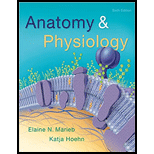
ANATOMY&PHYSIOLOGY W/CD+ATLAS+ACCESSCO
6th Edition
ISBN: 9780134428710
Author: Marieb
Publisher: PEARSON
expand_more
expand_more
format_list_bulleted
Concept explainers
Textbook Question
Chapter 20, Problem 6MC
Small molecules that must combine with large proteins to become immunogenic are called (a) complete antigens, (b) kinins, (c) antigenic determinants, (d) haptens.
Expert Solution & Answer
Want to see the full answer?
Check out a sample textbook solution
Students have asked these similar questions
How does the body produce so many highly diverse antibodies to respond to essentially any possible antigen?
how does the body differentiate between self and non-self antigens?
What is the function of an antigen-presenting cell?
Chapter 20 Solutions
ANATOMY&PHYSIOLOGY W/CD+ATLAS+ACCESSCO
Ch. 20.1 - What distinguishes the innate defense system from...Ch. 20.1 - What is the first line of defense against disease?Ch. 20.2 - What is opsonization and how does it help...Ch. 20.2 - Under what circumstances might NK cells kill our...Ch. 20.2 - What are the cardinal signs of inflammation and...Ch. 20.3 - Name three key characteristics of adaptive...Ch. 20.3 - What is the difference between a complete antigen...Ch. 20.3 - What marks a cell as self as opposed to nonselfCh. 20.4 - What event (or observation) signals that a B or T...Ch. 20.4 - Which of the following T cells would survive...
Ch. 20.4 - Prob. 11CYUCh. 20.4 - In clonal selection, who does the selecting? What...Ch. 20.5 - Why is the secondary response to an antigen so...Ch. 20.5 - Prob. 14CYUCh. 20.5 - Which class of antibody is most abundant in blood?...Ch. 20.5 - List four ways in which antibodies can bring about...Ch. 20.5 - Prob. 17CYUCh. 20.6 - Class II MHC proteins display what kind of...Ch. 20.6 - Which type of T cell is the most important in both...Ch. 20.6 - Describe the killing mechanism of cytotoxic T...Ch. 20.7 - Prob. 21CYUCh. 20.7 - Prob. 22CYUCh. 20 - All of the following are considered innate body...Ch. 20 - The process by which neutrophils squeeze through...Ch. 20 - Antibodies released by plasma cells are involved...Ch. 20 - Which of the following antibodies can fix...Ch. 20 - Which antibody class is abundant in body...Ch. 20 - Small molecules that must combine with large...Ch. 20 - Lymphocytes that develop immunocompetence in the...Ch. 20 - Cells that can directly attack target cells...Ch. 20 - Prob. 9MCCh. 20 - The cell type most often invaded by HIV is a(n)...Ch. 20 - Complement fixation promotes all of the following...Ch. 20 - Using the letters from column B, match the cell...Ch. 20 - Besides acting as mechanical barriers, the skin...Ch. 20 - Explain why attempts at phagocytosis are not...Ch. 20 - What is complement? How does it cause bacterial...Ch. 20 - Interferons are referred to as antiviral proteins....Ch. 20 - Differentiate between humoral and cellular...Ch. 20 - Although the adaptive immune system has two arms,...Ch. 20 - Define immunocompetence and self-tolerance. How is...Ch. 20 - Differentiate between a primary and a secondary...Ch. 20 - Prob. 21SAQCh. 20 - What is the role of the variable regions of an...Ch. 20 - Name the five antibody classes and describe where...Ch. 20 - How do antibodies help defend the body?Ch. 20 - Do vaccines produce active or passive humoral...Ch. 20 - Prob. 26SAQCh. 20 - Describe the specific roles of helper, regulatory,...Ch. 20 - Prob. 28SAQCh. 20 - Prob. 29SAQCh. 20 - What events can result in autoimmune disease?Ch. 20 - Prob. 1CCSCh. 20 - Prob. 2CCSCh. 20 - Prob. 3CCSCh. 20 - Prob. 4CCSCh. 20 - Remember Mr. Ayers, the bus driver from Chapter...
Knowledge Booster
Learn more about
Need a deep-dive on the concept behind this application? Look no further. Learn more about this topic, biology and related others by exploring similar questions and additional content below.Similar questions
- How do B and T cells differ with respect to antigens that they bind?arrow_forwardWhat is the difference between an allergy and an autoimmune response?arrow_forwardWhat is the term for a cluster of connected antigen, antibody and complement molecules, and is in circulation? Is it the lymphatic? Does the lymphatic includes antibodies? Or is it mucous? But is mucous in circulation? Or is it blood?arrow_forward
arrow_back_ios
arrow_forward_ios
Recommended textbooks for you
 Concepts of BiologyBiologyISBN:9781938168116Author:Samantha Fowler, Rebecca Roush, James WisePublisher:OpenStax College
Concepts of BiologyBiologyISBN:9781938168116Author:Samantha Fowler, Rebecca Roush, James WisePublisher:OpenStax College Human Biology (MindTap Course List)BiologyISBN:9781305112100Author:Cecie Starr, Beverly McMillanPublisher:Cengage Learning
Human Biology (MindTap Course List)BiologyISBN:9781305112100Author:Cecie Starr, Beverly McMillanPublisher:Cengage Learning

Concepts of Biology
Biology
ISBN:9781938168116
Author:Samantha Fowler, Rebecca Roush, James Wise
Publisher:OpenStax College

Human Biology (MindTap Course List)
Biology
ISBN:9781305112100
Author:Cecie Starr, Beverly McMillan
Publisher:Cengage Learning
Immune System and Immune Response Animation; Author: Medical Sciences Animations;https://www.youtube.com/watch?v=JDdbUBXPKc4;License: Standard YouTube License, CC-BY
Immune response: summary; Author: Dr Bhavsar Biology;https://www.youtube.com/watch?v=ADANgHkX4OY;License: Standard Youtube License